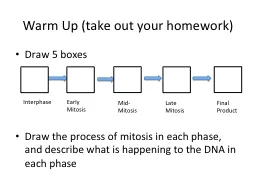PPT-Warm Up (take out your homework)
Author : danika-pritchard | Published Date : 2017-12-07
Draw 5 boxes Draw the process of mitosis in each phase and describe what is happening to the DNA in each phase Interphase Early Mitosis Mid Mitosis Late Mitosis
Presentation Embed Code
Download Presentation
Download Presentation The PPT/PDF document "Warm Up (take out your homework)" is the property of its rightful owner. Permission is granted to download and print the materials on this website for personal, non-commercial use only, and to display it on your personal computer provided you do not modify the materials and that you retain all copyright notices contained in the materials. By downloading content from our website, you accept the terms of this agreement.
Warm Up (take out your homework): Transcript
Download Rules Of Document
"Warm Up (take out your homework)"The content belongs to its owner. You may download and print it for personal use, without modification, and keep all copyright notices. By downloading, you agree to these terms.
Related Documents














